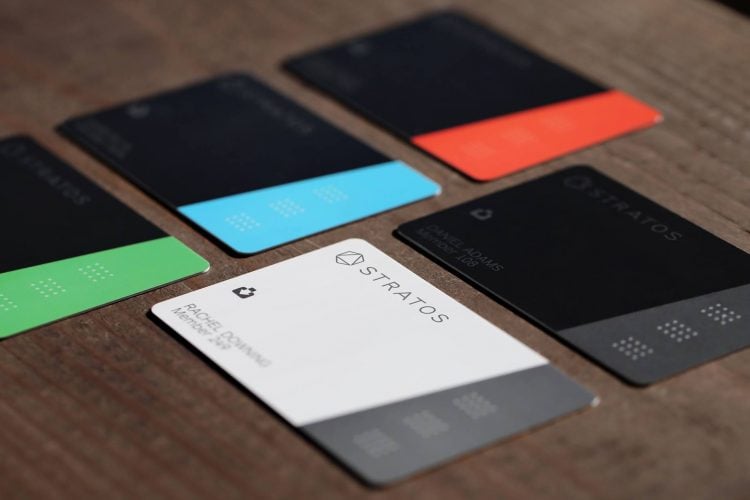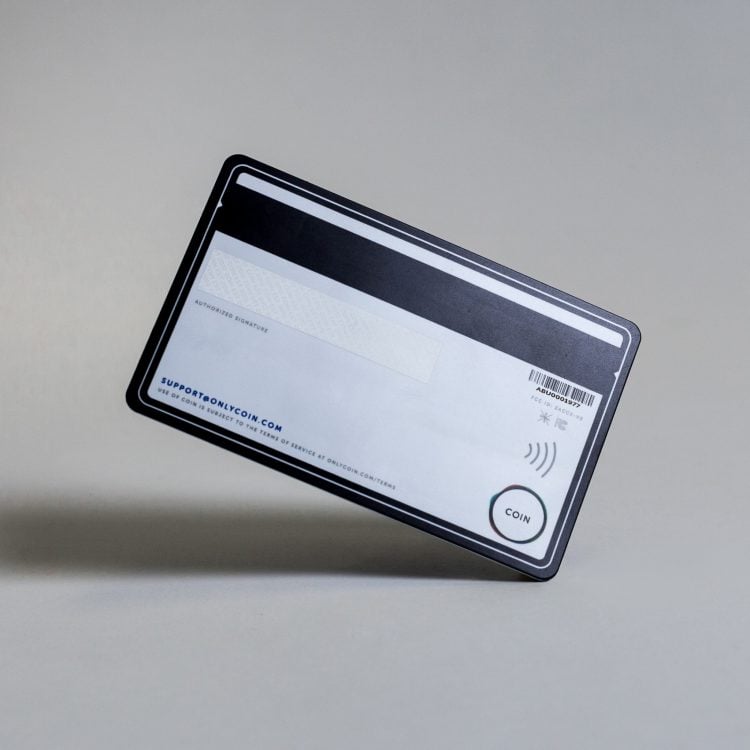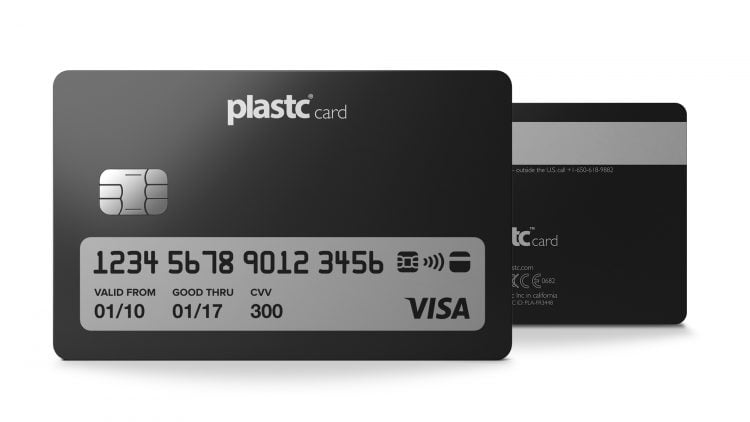Stratos, Coin, Plastc, Swyp: Sizing Up Multi-Account Cards

Many or all of the products featured here are from our partners who compensate us. This influences which products we write about and where and how the product appears on a page. However, this does not influence our evaluations. Our opinions are our own. Here is a list of our partners and here's how we make money.
UPDATE April 21, 2017: Since this article was published in November 2015, there have been big changes in the market for multi-account "smart" cards. The spread of mobile wallets such as Apple Pay and Samsung Pay severely undercut the anticipated demand for these products, and many have been discontinued. Of the manufacturers identified in this article:
Stratos was acquired by the Danish company CardLab; as of April 2017, it was still supporting the service but was not shipping new cards
Coin was acquired by Fitbit, and its service has been discontinued
Swyp was not producing new cards as of April 2017
Plastc ceased operations before it could deliver a product to consumers
Below is our article from 2015 describing how these products worked.
Carrying around a bulging wallet full of cards is so 2010.
Multi-account cards allow you to store information from multiple credit, debit, loyalty and gift cards on a single device that looks and works much like a regular credit card. Though the technology is still developing, the cards on the market are promising a level of convenience unimaginable just a few years ago. Among their benefits:
Security: Most devices incorporate password protection, so a stolen card is essentially worthless to someone without the code.
Simplicity: Users don’t have to carry multiple cards to maximize rewards and cash back.
Easier tracking and budgeting: The devices consolidate spending history across all accounts.
To pay with most of the multi-account cards on the market, users swipe a magnetic stripe through a reader. Beyond that, each device comes with its own twists on functionality and style.
Here’s a roundup of some of the most popular and promising multi-account cards.
Stratos: Simple to use

Cost: $95 for a yearly membership, or $145 for two years.
Stratos is one of several multi-account cards that charges users a yearly fee, which covers an annual upgrade. Some other companies allow consumers to pay an upfront fee, then decide whether they want to buy updated hardware, much like wireless phone carriers.
Number of cards device can store: The Stratos app can store an unlimited number of cards, but users can load only three cards onto the device at a time. Paying with a card not loaded onto the device requires opening the app on a mobile phone and selecting a new card to add to the rotation. For most people, immediate access to three cards is probably enough. But other devices allow users to load many more.
Battery life: Stratos does not come with a charger, though the company says the battery lasts an estimated two years. When your card gets low on juice, Stratos detects the battery level and sends you a replacement at no extra charge.
How it works: To begin the payment process with Stratos, you tap the device once against a hard surface, activating the card in the first position on the device. Tapping twice triggers three blinking LED touch sensors, which you use to pick a card. Once a card is selected, you can swipe Stratos like a regular card.
There is no display on Stratos that shows which light represents which card, but the options are automatically displayed on your phone. Without a phone, you’ll have to remember where each card is slotted, which might result in using the wrong card for a purchase and missing out on rewards — or, worse, getting hit with an overdraft fee.
If Stratos’ lock function is on, and your phone isn’t nearby or the battery dies, that will render the card inoperable. The device can be used without the lock function on, but that poses the risk of fraudulent use should you lose it.
Payment compatibility: Stratos does not currently work with standard EMV-chip contact readers or NFC (near-field communication) readers.
Coin 2.0: Enables contactless payments

Number of cards device can store: The Coin app can store an unlimited number of cards and sync up to eight to the device.
Battery life: The card’s battery cannot be recharged, but the company estimates it will last around two years, after which the device must be replaced.
How it works: Coin is not bound to a mobile phone. Its small screen allows users to see the type of card that’s activated, as well as the last four digits of the card’s account number and expiration date. The card will unlock if it detects a synced phone nearby or if a tap code is entered using Coin’s only button.
Payment compatibility: Coin 2.0 integrates NFC technology — a feature notably missing from several other multi-account cards — which allows users to pay with EMV cards via contactless terminals such as those used with Apple Pay. However, Coin 2.0 will not work with EMV-chip contact readers that require you to insert your card.
Coin’s magstripe transmits card information, but not the cardholder’s name. As a result, merchant terminals that require a card to transmit both when swiped won’t be compatible with Coin.
Swyp: Holds the most cards
Number of cards device can store: Like most other smart cards, Swyp’s app can store an unlimited number of cards. The Swyp device itself can hold a whopping 25 cards, more than any other multi-account card in our roundup. Though most users will probably stretch to fill their Swyp with that many cards, it’s certainly better to have more options than not enough.
Battery life: Swyp’s battery does come with a charger, though the company claims that with normal use, the card should last around a year on a single charge.
How it works: The device has a small display, most similar to that of Coin’s. For credit cards, the screen displays the name of the card, network, last four digits of the account number, expiration date, and CVV. For other types of cards, such as debit or gift cards, the information shown may vary.
Much as with the Coin and Stratos, users toggle through their cards using tactile buttons on the card’s face. As with other electronic wallets, adding cards involves swiping them through a reader connected to your phone, and linking the card to your phone via Bluetooth. A phone doesn’t have to be present to use the device.
Payment compatibility: Swyp has a magstripe and an EMV chip, but doesn’t come with NFC technology, though the company has plans to add it. Barcodes, such as those found on many loyalty cards, can be added and used through the app.
Plastc: Payment versatility expected
Cost: The Plastc device, which won't be released until April, will sell for $180; that will include an 18-month subscription. Ongoing service will be available for $50 a year.
Number of cards device can store: The Plastc Wallet app can store an unlimited number of cards. The device itself can hold an impressive 20 debit, credit, loyalty or gift cards for access at any time.
Battery life: Plastc’s battery is said to last an estimated 30 days, but the card will come with a charger.
How it works: The most notable difference between Plastc and its competitors is that it has a large touchscreen that takes up about one-third of the device’s face. The screen serves a number of functions: It allows you to unlock the device with a PIN, displays information — such as card balance, account number, CVV and card type — and even shows biometric security images, such as a photo of the cardholder and his or her signature. The screen displays barcodes too, allowing users to scan loyalty cards.
Folks already comfortable with touchscreens may find the card more intuitive to use — especially compared with cards that require leaning heavily on the phone for functionality, or ones that require use of somewhat clunky push-buttons.
Because Plastc hasn’t been released yet, there’s no word from consumers on how smoothly it actually works.
Payment compatibility: Plastc is the only card in our review that promises to incorporate magnetic stripe, NFC and chip-and-PIN in a single device. It may be among the most versatile multi-account cards when it’s released.
The bottom line
It’s important to compare each card’s cost and features. Consider how many cards you need available to you, how involved you want your phone to be in managing your cards, and whether you prefer to pay a one-time fee with no upgrades or subscribe to a model with automatic upgrades. One thing is for certain: Whichever card you choose, it’s sure to take some of the weight off your wallet.
Find the right credit card for you.
Whether you want to pay less interest or earn more rewards, the right card's out there. Just answer a few questions and we'll narrow the search for you.




